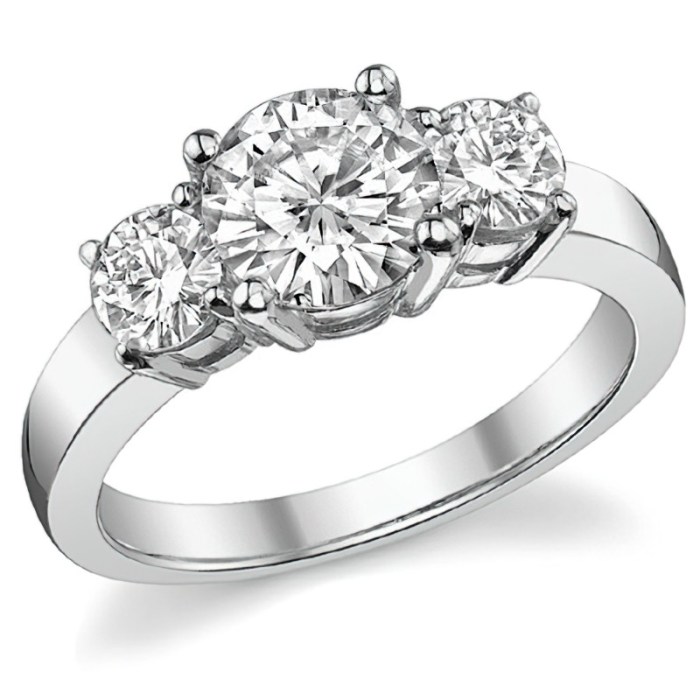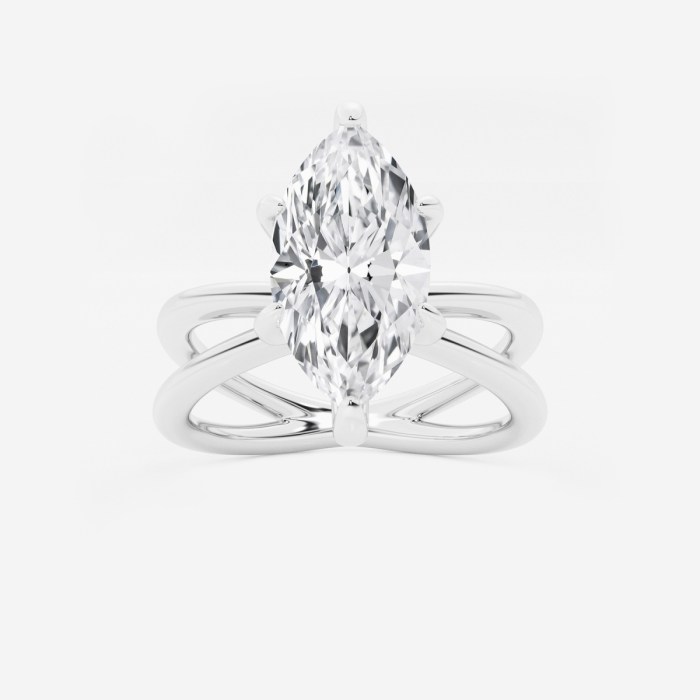Lab grown diamond ring companies are revolutionizing the jewelry industry with their ethically sourced and affordable alternatives to natural diamonds. These innovative firms utilize advanced technology to create stunning diamonds in controlled environments, resulting in gems that are chemically identical to their mined counterparts. Not only do lab-grown diamonds offer a more sustainable option, but they also come with a unique story that adds depth to their beauty.
As consumers become more conscious about their purchasing decisions, lab grown diamonds have gained tremendous popularity, prompting a rise in companies dedicated to this craft. Understanding the differences between lab grown and natural diamonds, along with the benefits of choosing lab grown options, is essential for anyone considering an engagement ring or a special piece of jewelry.
Overview of Lab Grown Diamond Rings

Source: com.au
Lab grown diamond rings are an innovative and sustainable alternative to traditional natural diamond jewelry. These exquisite rings offer the same beauty and brilliance as their mined counterparts, with the added benefits of ethical sourcing and environmental consciousness. As more consumers seek responsible luxury, lab grown diamonds have become a popular choice for engagements and special occasions.The process of creating lab grown diamonds involves two primary methods: High Pressure High Temperature (HPHT) and Chemical Vapor Deposition (CVD).
Both techniques replicate the natural conditions under which diamonds form in the Earth’s mantle. In the HPHT method, carbon is subjected to extreme pressure and temperature, simulating natural diamond formation. CVD, on the other hand, involves the use of gas mixtures to deposit carbon atoms onto a substrate, allowing them to crystallize into diamond form. This controlled environment results in diamonds that are chemically and physically identical to natural diamonds.
Differences Between Lab Grown Diamonds and Natural Diamonds
Understanding the distinctions between lab grown diamonds and natural diamonds is essential for informed purchasing. While both types of diamonds share the same chemical composition, there are notable differences in their origins and market perception.
- Lab grown diamonds are manufactured in controlled environments, while natural diamonds are mined from the Earth.
- The pricing of lab grown diamonds is generally lower, often 20-40% less than natural diamonds due to lower production costs.
- Lab grown diamonds often come with certification that explicitly states their origin, ensuring transparency for consumers.
- Environmental impact is significantly reduced with lab grown diamonds, as they do not require mining, which can result in habitat destruction and ecological disruption.
Lab grown diamonds present a sustainable luxury choice, combining ethical considerations with stunning aesthetics.
Benefits of Choosing Lab Grown Diamond Rings
There are numerous advantages to selecting lab grown diamonds, making them an appealing choice for many buyers. The following points highlight the primary benefits:
Ethical Sourcing
Lab grown diamonds eliminate concerns about conflict diamonds, ensuring that your purchase does not contribute to unethical mining practices.
Cost-Effectiveness
With prices typically lower than natural diamonds, consumers can often afford a larger or higher-quality stone than they might otherwise be able to purchase.
Quality Assurance
Lab grown diamonds are graded by the same standards as natural diamonds and often feature fewer inclusions and greater clarity.
Customization
If you’re considering an investment in elegance, the harry winston diamond ring price is a key factor. Known for their exquisite craftsmanship, these rings not only symbolize love but also exceptional value. Whether you’re looking for something classic or modern, understanding the price range can help you make an informed decision about your purchase.
Many lab grown diamond retailers offer extensive customization options, allowing buyers to design a unique piece that reflects their personal style.By choosing a lab grown diamond ring, consumers can enjoy the beauty and significance of diamond jewelry while supporting sustainable practices and ethical choices.
Leading Companies in the Lab Grown Diamond Industry
The lab grown diamond industry has seen remarkable growth in recent years, with several companies emerging as key players in the market. These companies not only focus on manufacturing lab-grown diamond rings but also innovate in terms of sustainability and ethical sourcing. As consumers become more aware of their purchasing choices, knowing the leading companies in this space becomes essential for making informed decisions.Among the top companies in the lab grown diamond industry, each has its unique business model and approach to the market.
These businesses leverage advanced technology to create diamonds that are virtually indistinguishable from their mined counterparts, often at a more accessible price point. Understanding the distinct strategies and customer feedback for these companies provides insight into the overall consumer experience.
Top Companies Manufacturing Lab Grown Diamond Rings
Several companies have established themselves as leaders in the lab grown diamond sector, each with a commitment to quality and ethical practices. Here are some of the most prominent brands:
- Brilliant Earth: Known for its commitment to sustainability, Brilliant Earth offers a wide range of lab-grown diamond rings. They focus on ethical sourcing and environmentally friendly practices, appealing to eco-conscious consumers.
- James Allen: This company is recognized for its extensive selection of customizable lab-grown diamond rings. James Allen uses high-definition imagery and 360-degree video technology to provide customers with a detailed view of their diamond selections.
- Clean Origin: Specializing solely in lab-grown diamonds, Clean Origin emphasizes affordability without compromising quality. They provide a transparent shopping experience, allowing customers to trace the origins of their diamonds.
- Gemini: This brand distinguishes itself by focusing on fashion-forward designs and modern aesthetics. Gemini offers unique styles that appeal to a younger demographic seeking trendy jewelry.
Business Models of Leading Companies
The business models of leading lab grown diamond companies vary, reflecting their unique market positions and consumer engagement strategies. Most companies operate online, allowing for a broader reach and competitive pricing.
- Direct-to-Consumer (DTC) Model: Companies like Brilliant Earth and Clean Origin utilize a DTC approach, minimizing overhead costs and passing savings onto customers. This model fosters a direct relationship with buyers, enhancing customer service and satisfaction.
- Customization and Personalization: Brands like James Allen focus heavily on customization, offering customers the ability to design their rings from scratch. This level of personalization increases engagement and customer loyalty.
- Transparency and Education: Many leading companies prioritize educating consumers about lab-grown diamonds. This includes transparent pricing, detailed product information, and ethical sourcing practices, which help build trust with customers.
Customer Reviews and Ratings for Major Lab Grown Diamond Brands
Customer feedback plays a crucial role in evaluating the success and reputation of lab grown diamond companies. Reviews often focus on product quality, customer service, and overall shopping experience.
- Brilliant Earth: Customers frequently praise Brilliant Earth for its ethical practices and quality of diamonds, often rating the company 4.8 out of 5 stars on several review platforms.
- James Allen: Known for its excellent customer service, James Allen typically receives high ratings, with many customers commenting on the helpfulness of their representatives and the quality of their products.
- Clean Origin: Clean Origin often garners positive reviews for its affordability and straightforward shopping experience, with ratings averaging around 4.7 out of 5 stars.
- Gemini: Customers enjoy the unique designs offered by Gemini, with many noting the brand’s commitment to quality and style, resulting in ratings of about 4.5 out of 5 stars.
Customer satisfaction is essential in the lab-grown diamond market, with many companies prioritizing transparency and ethical practices to build trust.
Factors to Consider When Choosing a Lab Grown Diamond Ring: Lab Grown Diamond Ring Companies

Source: labgrown.com
When it comes to selecting a lab grown diamond ring, numerous factors can influence your decision. These diamonds, often indistinguishable from mined diamonds, come with unique characteristics that deserve careful consideration. Understanding these aspects will not only enhance your purchasing experience but also ensure that you make a choice that aligns with your style and values.One of the most critical elements to evaluate when purchasing a lab grown diamond ring is the diamond’s quality, which is typically assessed through the Four Cs: Cut, Color, Clarity, and Carat weight.
Each of these characteristics plays a vital role in determining the diamond’s overall aesthetic and value.
Understanding the Four Cs, Lab grown diamond ring companies
The Four Cs serve as the benchmark for evaluating diamond quality and are essential for making an informed purchase. Here’s a breakdown of each element:
- Cut: The cut of the diamond affects its brilliance and sparkle. Well-cut diamonds reflect light beautifully, while poorly cut stones may appear dull. Popular cuts include round, princess, and oval, each offering distinct visual appeal.
- Color: Lab grown diamonds are available in various color grades, from colorless to light yellow or brown. The less color present, the higher the value of the diamond. Aim for diamonds rated G-H for a near-colorless appearance.
- Clarity: Clarity refers to the presence of internal or external flaws (inclusions or blemishes). Higher clarity ratings indicate fewer imperfections. Aim for diamonds rated VS1-VS2 for a balance between quality and price.
- Carat weight: This measures the diamond’s size. While larger diamonds are often more desirable, it’s essential to balance carat weight with the other Cs to achieve the best overall value.
Importance of Certification and Quality Assurance
Certification plays a pivotal role in the lab grown diamond market. A reputable grading report from a recognized gemological laboratory provides assurance of the diamond’s quality based on the Four Cs. This certificate also guarantees that the diamond is indeed lab grown, ensuring ethical sourcing and environmental consideration.It is vital to choose diamonds that come with certification from respected institutions such as the Gemological Institute of America (GIA) or the International Gemological Institute (IGI).
A certified diamond not only provides peace of mind regarding its quality but also assists in maintaining its resale value.
If you’re curious about the harry winston diamond ring price , it’s essential to understand that these exquisite pieces often reflect their quality and craftsmanship. Prices can vary significantly based on factors like the size and clarity of the diamond, making it a worthwhile investment for those looking to make a statement with an elegant ring.
Checklist for Assessing Lab Grown Diamond Options
As you embark on your journey to find the perfect lab grown diamond ring, having a checklist can streamline your evaluation process. This list helps ensure you cover all important aspects of your potential purchase.Consider the following points:
- Does the diamond come with a certification from a recognized grading authority?
- What are the specifics of the Four Cs for this diamond? Have you compared these characteristics with others?
- Is the diamond ethically sourced, and does the company provide transparency about their production methods?
- Does the company offer a warranty or guarantee for the diamond and the ring setting?
- What is the return policy in case you change your mind after the purchase?
By keeping these factors in mind, you can confidently navigate the world of lab grown diamonds, ensuring that your choice is informed, ethical, and perfectly suited to your taste.
Trends and Innovations in Lab Grown Diamonds

Source: grownbrilliance.com
As the lab grown diamond industry continues to expand, several key trends and innovations are shaping its future. These developments not only reflect changing consumer preferences but also advancements in technology that enhance the quality and appeal of lab grown diamonds. Understanding these trends offers insights into how the market is evolving and what consumers can expect moving forward.Innovation in the lab grown diamond sector is driven by technological advancements and increasing awareness of ethical sourcing.
Notably, production techniques such as Chemical Vapor Deposition (CVD) and High-Pressure High-Temperature (HPHT) methods have revolutionized the way diamonds are created. Both methods allow for the creation of diamonds that are virtually indistinguishable from their mined counterparts, leading to an increase in their popularity among consumers seeking eco-friendly and ethical options.
Current Trends in the Lab Grown Diamond Market
The lab grown diamond market is experiencing several defining trends that highlight its growing acceptance and integration into mainstream jewelry. Some of the most prominent trends include:
- Increased Consumer Awareness: More consumers are recognizing the environmental and ethical advantages of lab grown diamonds, leading to higher demand.
- Customization and Personalization: Brands are offering bespoke options, allowing customers to choose specific characteristics such as cut, color, and clarity.
- Social Media Influence: Platforms like Instagram and Pinterest are showcasing lab grown diamonds, influencing younger generations to consider these alternatives.
- Competitive Pricing: Lab grown diamonds typically cost 20-40% less than mined diamonds, making them an attractive option for budget-conscious consumers.
Innovative Techniques Shaping the Future
Several cutting-edge techniques are propelling lab grown diamond production into new realms of efficiency and quality. These innovations include:
- Advanced CVD Technology: Improvements in CVD technology are allowing for larger and higher-quality diamonds to be produced more rapidly, offering greater value to consumers.
- Hybrid Methods: The development of hybrid techniques that combine CVD and HPHT methods is leading to enhanced diamond characteristics and a wider variety of options.
- 3D Printing of Diamond Jewelry: The integration of 3D printing technology into the jewelry-making process is enabling more intricate designs that were previously unattainable.
Forecast for the Lab Grown Diamond Industry
The future of the lab grown diamond industry looks promising, with projections indicating significant growth over the next decade. Industry analysts forecast that the market will grow at a compound annual growth rate (CAGR) of around 15-20%, driven by both increased consumer acceptance and ongoing technological advancements. This growth is likely to have a profound impact on traditional diamond markets.As lab grown diamonds become more mainstream, traditional diamond retailers may need to adapt their strategies to compete with the rising popularity of lab created options.
The shift in consumer preferences could lead to a reevaluation of pricing in the natural diamond sector, potentially resulting in decreased prices for mined diamonds. In essence, the lab grown diamond revolution is not just changing the landscape for new buyers; it’s prompting traditional markets to reconsider their value propositions and ethical considerations in the jewelry industry.
End of Discussion

Source: squarespace-cdn.com
In summary, the emergence of lab grown diamond ring companies has transformed the landscape of the diamond industry, presenting consumers with a thoughtful and sustainable choice. With advancements in technology and a growing number of reputable brands, finding the perfect lab grown diamond ring that suits individual tastes and values has never been easier. As this trend continues to evolve, embracing lab grown diamonds not only supports ethical practices but also reflects a modern approach to jewelry shopping.
Key Questions Answered
What are lab grown diamonds?
Lab grown diamonds are diamonds created in a controlled environment using advanced technology, replicating the natural diamond formation process.
Are lab grown diamonds more affordable than natural diamonds?
Yes, lab grown diamonds typically cost 20-40% less than natural diamonds due to lower production costs.
Do lab grown diamonds hold their value?
Lab grown diamonds may not retain value as well as natural diamonds, but their appeal is growing, and resale markets are developing.
How do I know if a diamond is lab grown?
Certification from reputable gemological laboratories will indicate whether a diamond is lab grown or natural.
Can lab grown diamonds be used in engagement rings?
Absolutely! Lab grown diamonds make beautiful and ethical choices for engagement rings.